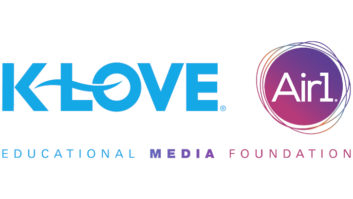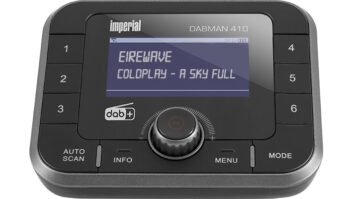
Brian Sanders examines the dish antenna for the AP wire service; the NPR receive dish and larger C-band uplink dish are at the back.
FLAGSTAFF, Ariz. With the nearest contract broadcast engineer sometimes a half-day away, Brian Sanders has been forced to learn his way around the old toolbox in order to help keep his stations on the air.
Sanders, network operations manager for non-commercial KNAU(FM) in Flagstaff, oversees a far-flung web of 13 stations across the mountains of northern Arizona, and among his current challenges is expansion of its new C-band satellite distribution system.
“I’m a generalist. I know how to do a lot of different things in broadcast, from being on the air to rebuilding studio and fixing equipment. I’ve done this long enough to learn a few things,” he said. “I’m the guy with the Rolodex. I know who to call if I can’t fix it.”
Sanders as the top technical person is responsible for facilities including the network chain of transmitters, studios and content distribution. He relies on contract engineers for RF work.
The network coverage map for KNAU, Arizona Public Radio, includes nearly all of the northern half of the state, including the Hopi and Navajo Reservations, and stretches from the southern rim of the Grand Canyon to the northern fringes of the Phoenix metro.

Sanders is network operations manager for non-commercial KNAU(FM) in Flagstaff; he oversees a network of 13 stations across the mountains of northern Arizona. KNAU, which is licensed to Northern Arizona University, signed on in 1983 and has constructed 12 additional broadcast transmission sites, a combination of associate stations and low-power translators. Sanders joined KNAU in 2007. The operation produces two program streams; classical music originates on KNAU at 88.7 MHz in Flagstaff, while news/talk programming originates on KPUB at 91.7 MHz from the same facility. Those formats are also carried on four outlying FMs and seven low-power translators. The sister stations, or “robots” as Sanders called them, are in rural areas in places like Payson and Cottonwood, Ariz.
The network carries local content from KNAU’s studios in addition to programming from National Public Radio, Public Radio International and American Public Media. It also streams its two formats via the Internet at www.knau.org.
Sanders, 56, has been in radio for 35 years. He grew up near Chicago and began his career on-air, making stops at commercial stations in Urbana and then Champaign, Ill., before joining Nevada Public Radio’s KNPR(FM) in Las Vegas in 1981.
Both sides of the aisle
“I’ve worked from mom-and-pop operations to larger commercial operations. Public radio is my favorite. Public radio offers tremendous programming quality,” Sanders said.
“There is attention to audio quality and lots of niche programming, like classical music. There is a degree of flexibility here without a huge layer of bureaucracy and administration.”

The facilities of KNAU Arizona Public Radio reach much of the northern half of the state. Sanders was “Morning Edition” host at noncommercial KCRW(FM) in Santa Monica, Calif., for nearly six years before coming to Flagstaff and settling in among the Ponderosa Pines at Northern Arizona University. He also was remote engineer for KTWV(FM) in Los Angeles.
Among his KNAU duties, Sanders is the go-to guy for solving any problems with office software, computers, printers and so on. He also manages the station’s AudioVault automation and satellite uplink operations.
He has served as project manager overseeing KNAU’s construction of a C-band satellite distribution system, which this year completed its first downlink install for network affiliate KNAD(FM) in Page, Ariz. More downlink sites will follow in Prescott, Show Low and at the Grand Canyon, he said, as fundraising permits. KNAU distributes its news/talk programming to KNAD over leased transponders of the NPR satellite distribution system on Galaxy 16. KNAU uses a Radyne DMD20 satellite modem while the affiliate uses a Tiernan ABR202A receiver.
“I’ve been working on this (C-band) project to two years. We completed the uplink portion from our main studios in Flagstaff last summer. We have historically used a system of on-air repeaters to reach audio to the outlying stations. We do still operate one audio-over-IP service to the translator in Prescott using a Barix box,” Sanders said.
The satellite interconnection system for distribution of Arizona Public Radio programming will result in more reliable service, Sanders said.
Audio over IP
At one time, some of its outlying stations had local origination capabilities, but no longer, Sanders said. The stations now are all basically RF sites that are remotely controlled.
He has a contact person in each station’s listening area whom he calls when he gets an off-air alarm; Sanders then assesses the situation and either drives to the site himself or dispatches a contract engineer to fix the problem.
Sanders, who plays the sax and clarinet, lives with his wife, Constance DeVereaux, a senior lecturer at Northern Arizona University, in Flagstaff. He compares his transmitter sites to his two stepchildren. “They all have individual needs,” he says. “Some of the sites are more reliable than others. I try to visit each site somewhat regularly.”
KNAU’s main studios, located on the south end of campus, are straightforward by design, Sanders said.
“The facilities are 15 years old and are very basic. For studios we have kept it simple from a technical operator point of view. We have had, over the years, a lot of non-radio people work here, so simplicity is good. We have three studios, an on-air, production and aux studio, which can all be put on the air needed.”
Next on Sanders’ list of things to do is an eventual studio rebuild at KNAU. “I cannot run any more wire or conduit. Too much gunk in the plumbing to do anything more with it.”
He wants to rebuild the studios using audio over IP, which “offers so much more versatility, expandability, and will be cheaper. Cost is always a concern.”
Sanders, who describes AoIP as “the new sliced bread,” has been learning about AoIP at recent NAB conventions in Las Vegas; in fact he was the recipient of a $1,000 scholarship from the Association of Public Radio Engineers to attend the 2009 Public Radio Engineering Conference, which precedes the show. That scholarship is funded by APRE members and several equipment manufacturing sponsors.
Sanders, who has no formal technical training, attended AoIP seminars and meetings last year, and returned for the 2010 NAB Show.

Brian Sanders works at the automation control center in the Technical Operations Center at Arizona Public Radio. A satellite radio user for a short time before discontinuing the subscription, Sanders has high hopes for the future of terrestrial radio, especially public radio.
“We always think of the notion that we are not just radio people, but rather content people. People are not using radio for music as much as they used to. But what NPR has to offer in real time news and information is really unduplicated anywhere else.”
One thing not in the future for KNAU or its stations is HD Radio, Sanders said.
“We’ve concluded that HD Radio is not viable here in rural Arizona and have serious doubts as to whether HD will ever be popular with listeners, even in more populated areas.”
Flagstaff, a city of approximately 62,000 residents, often is listed on those “most desirable places to live” lists. Only 90 minutes from the Grand Canyon and considered a hiker’s paradise, the community is supportive of KNAU’s fundraising efforts and has helped the station reach its fund raising goals on a regular basis, he said.
“There are a lot of well-educated people living in this area. This is a community of life-long learners who are quick to volunteer and come to our aid when we need it.”







